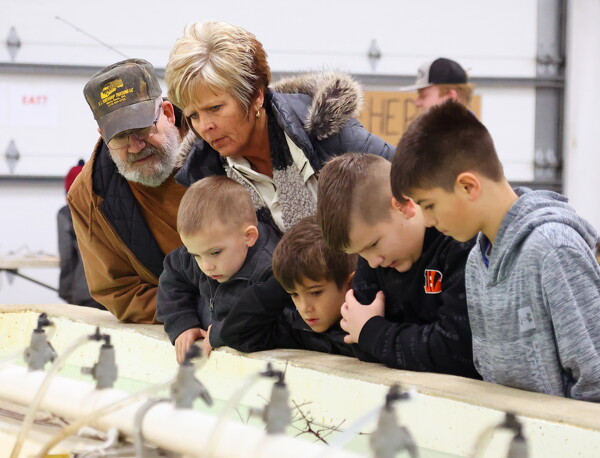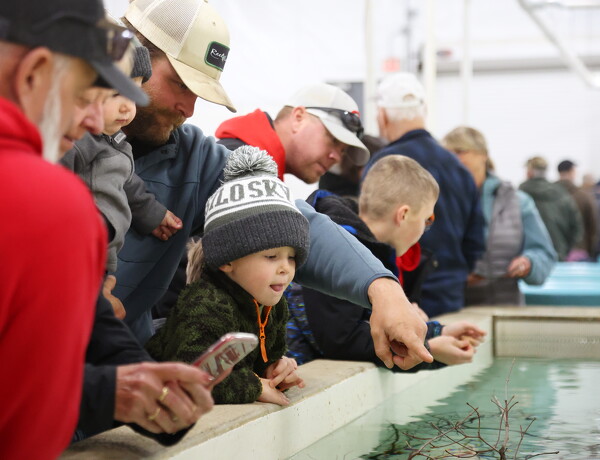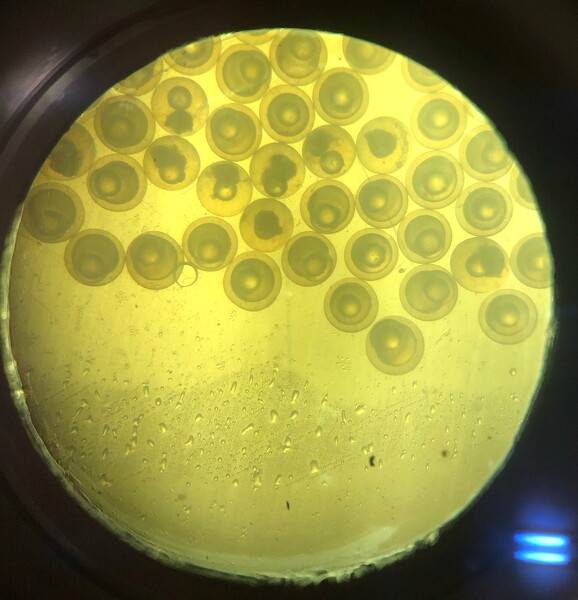
Hundreds of people came out to St. Marys Fish Hatchery's open house on Saturday.
ST. MARYS - The St. Marys Fish Hatchery opened its doors to the public on Saturday amid an exciting, high-activity period - spawning season for yellow perch, a gamefish highly coveted by anglers across Ohio.
Last year, roughly 3.1 million yellow perch fry and 2.3 million yellow perch fingerlings were produced at the hatchery and stocked at dozens of lakes throughout Ohio. Fry are quarter-inch long hatchlings aged 1 to 5 days. Fish older than that are known as fingerlings.
"We're the only state hatchery that raises yellow perch. This is a unique time of the year for yellow perch because they spawn in Ohio one time a year," said hatchery manager Jay Williams. "Right now we've got nine million yellow perch incubating."

Hundreds of people came out to St. Marys Fish Hatchery's open house on Saturday.
And people on Saturday came out in the hundreds - families and wildlife enthusiasts alike - to get a behind-the-scenes look at the hatchery's production building that sits on 155 acres of land off state Route 364 along Grand Lake's eastern shore.
The vast estate owned by the state contains 26 ponds comprising 45 acres of water, according to Williams.
The hatchery produces millions of fish each year, starting with walleye, saugeye and yellow perch in the spring and later on channel catfish and blue catfish fry.

A microscopic view of a 2-day-old saugeye fish eggs.
While offering an overview of the hatchery to The Daily Standard, Williams largely focused on the fish of the hour, the yellow perch.
Yellow perch typically spawn from mid-March to the end of the month, in a hatchery setting.
"With so much that goes into fish spawning, they get a lot of their egg development from environmental cues in the body. Even when mid-March comes, there's a whole lot in the perch body that's already gone on," Williams said. "The females are already swelled up with eggs. The males, they're already ready to go."
Captive broodstock living in hatchery ponds are brought inside the production building to spawn.
"These fish are 5 years old. If they could talk they would probably tell you our names, we've handled them so much," Williams said.
Female broodstock are injected with a hormone naturally found in pregnant women that is purified and sold on the market.
"That hormone specifically bypasses a lot of things in the brain of a fish and it acts directly on fish placenta and it matures that real fast," he explained.
Up to 120 males and 120 females are placed in each of the hatchery's tanks that are filled with onsite well water kept at a constant temperature of 54 degrees.
"We'll put a cover over them and in four days they'll start laying eggs. The males and females, they'll fertilize them themselves. We don't have to hand-spawn anything," Williams said.
Hatchery staff, who immerse themselves in research and development and visit colleges to learn from specialists, have achieved fertilization rates ranging from 90% to 100%, about as good as it can get, Williams said.

Each 10- to 12-inch female produces as many as 40,000 eggs contained in gelatinous strand called a ribbon.
Each 10- to 12-inch female produces as many as 40,000 eggs contained in gelatinous strand called a ribbon, Williams pointed out. Ribbons up to 6-feet long are then placed in incubators.
"They'll incubate in there for 12 to 13 days," he said as he handled a ribbon. "They'll develop inside that ribbon and as the eggs age and the ribbons ages, it will start to break down."

A magnified image of 7-day-old yellow perch eggs.
In nature, yellow perch spawn on vegetation and rely on wind and wave action to break up the ribbon and hatch the fry. Those conditions must be replicated in the aquaculture setting of the hatchery.
"We've found the hard way … if you let these incubating eggs go to Day 14, Day 15, we'll get a lot more death," Williams said.
Each ribbon of eggs is placed into a 5-gallon bucket half-filled with water. Williams said staff use a paint stirrer to agitate the mix, "really fast, almost hurricane fast."
"What we're trying to do is physically, forcefully hatch those fish out of the egg, and a lot of them will be swimming around," Williams said. "It may seem a little bit crass on how we do it, but it's actually pretty cutting edge, putting them in a bucket, grinding them up. It seems a little harsh but it's necessary."
The fry are placed in a hatchery pond for about 40 days where they grow up to 1 1/2 inches long.
Some, though, may be put in a plastic bag with water and oxygen and stocked into a lake shortly after emerging from their eggs.
"We can fry stock those into a lake. That's only if and when we run out of hatchery pond space," Williams said.
Through a combination of experimentation, research and trial and error, staff have improved efficiency and production at the hatchery.
"I've been here for 28 years and for the last 10 years we have made leaps and bounds on how we do it now," he said.

Incubation jars containing saugeye and walleye fish eggs are on display at the St. Marys State Fish Hatchery open house Saturday.
The hatchery opened in 1913 and was originally operated by the Western Ohio Fish and Game Association and then transferred to the Ohio Division of Conservation, predecessor of Ohio Department of Natural Resources Division of Wildlife, in 1936, according to ODNR.
The local hatchery at 1735 Feeder Road is one of six in the state. The others are in Hebron, Senecaville, London, Castalia and Latham.
Together, the hatcheries raised and stocked more than 52 million fish in 2022, according to an ODNR news release.
Stocking expands fishing opportunities statewide by bolstering fish populations where natural reproduction is insufficient or not possible for a particular species, the release states.
"Requests to stock fish come from district biologists based on their surveys," Williams said. "The lakes will vary from year to year. Maybe every other lake, they want to stock that with yellow perch. Maybe every five years they want to put yellow perch in."
Williams said he believes 35 to 40 lakes will be stocked with yellow perch this year.